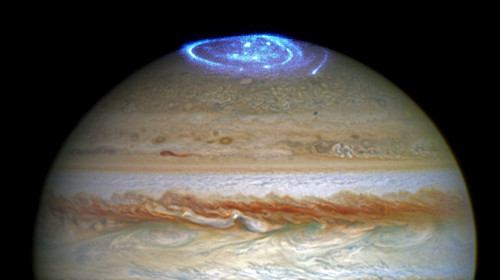Sidusglacies - ⚡️

More Posts from Sidusglacies and Others

Like Earth, Jupiter is home to polar auroras that light the sky as charged particles interact with the planet’s magnetosphere. A recent paper identifies interesting features in the aurora that appear similar to expanding vortex rings.(Image credit: Jupiter - NASA, ESA, and J. Nichols, aurora features - NASA/SWRI/JPL-Caltech/SwRI/V. Hue/G. R. Gladstone/B. Bonfond; research credit: V. Hue et al.; via Gizmodo)


ah yes the solar system… mercury, venus, earth, mars, jupiter, saturn, uranus, neptune, pluto?, and kirby… WAIT A SECOND

What are Trans-Neptunian object?
A trans-Neptunian object (TNO), also written transneptunian object, is any minor planet or dwarf planet in the Solar System that orbits the Sun at a greater average distance than Neptune, which has a semi-major axis of 30.1 astronomical units (AU).
The first trans-Neptunian object to be discovered was Pluto in 1930. It took until 1992 to discover a second trans-Neptunian object orbiting the Sun directly, 15760 Albion. The most massive TNO known is Eris, followed by Pluto, Haumea, Makemake, and Gonggong. source
i swear i’m going to give you the best goddamn hug you’ve ever had as soon as i can







Fallstreak hole
-
 zindabad liked this · 3 years ago
zindabad liked this · 3 years ago -
 808beat reblogged this · 3 years ago
808beat reblogged this · 3 years ago -
 808beat liked this · 3 years ago
808beat liked this · 3 years ago -
 xxwingsxofxpestilence liked this · 4 years ago
xxwingsxofxpestilence liked this · 4 years ago -
 astronautjaws liked this · 4 years ago
astronautjaws liked this · 4 years ago -
 hexblade liked this · 4 years ago
hexblade liked this · 4 years ago -
 sidusglacies reblogged this · 4 years ago
sidusglacies reblogged this · 4 years ago -
 cosmicwand3r3r liked this · 4 years ago
cosmicwand3r3r liked this · 4 years ago -
 boyist liked this · 4 years ago
boyist liked this · 4 years ago -
 shoestoreslore liked this · 5 years ago
shoestoreslore liked this · 5 years ago -
 71002milk liked this · 5 years ago
71002milk liked this · 5 years ago -
 night-sorrows liked this · 5 years ago
night-sorrows liked this · 5 years ago -
 shadovvlurking liked this · 6 years ago
shadovvlurking liked this · 6 years ago -
 skinsaq liked this · 6 years ago
skinsaq liked this · 6 years ago -
 dismorfofobie liked this · 6 years ago
dismorfofobie liked this · 6 years ago -
 cultofdreams liked this · 6 years ago
cultofdreams liked this · 6 years ago -
 punnypyro liked this · 6 years ago
punnypyro liked this · 6 years ago -
 lighthouse-in-a-storm liked this · 6 years ago
lighthouse-in-a-storm liked this · 6 years ago -
 sa-x reblogged this · 6 years ago
sa-x reblogged this · 6 years ago -
 painhaver-moved reblogged this · 6 years ago
painhaver-moved reblogged this · 6 years ago -
 cmdthenerd liked this · 6 years ago
cmdthenerd liked this · 6 years ago -
 poseidonhatesme liked this · 6 years ago
poseidonhatesme liked this · 6 years ago -
 pizzalawyer420 liked this · 6 years ago
pizzalawyer420 liked this · 6 years ago -
 224snails liked this · 6 years ago
224snails liked this · 6 years ago -
 morgonofhed liked this · 6 years ago
morgonofhed liked this · 6 years ago -
 thinkagainffxv reblogged this · 6 years ago
thinkagainffxv reblogged this · 6 years ago -
 tediouslibrarian liked this · 6 years ago
tediouslibrarian liked this · 6 years ago -
 seassidess liked this · 6 years ago
seassidess liked this · 6 years ago -
 lampyr1dae liked this · 6 years ago
lampyr1dae liked this · 6 years ago -
 asstroknot reblogged this · 6 years ago
asstroknot reblogged this · 6 years ago -
 britomartis reblogged this · 6 years ago
britomartis reblogged this · 6 years ago -
 britomartis liked this · 6 years ago
britomartis liked this · 6 years ago -
 astercrash liked this · 6 years ago
astercrash liked this · 6 years ago -
 moonlit-tide reblogged this · 6 years ago
moonlit-tide reblogged this · 6 years ago -
 moonlit-tide liked this · 6 years ago
moonlit-tide liked this · 6 years ago -
 aeonn-vs-the-world liked this · 6 years ago
aeonn-vs-the-world liked this · 6 years ago -
 weedlovingweed liked this · 6 years ago
weedlovingweed liked this · 6 years ago -
 wildfandom reblogged this · 6 years ago
wildfandom reblogged this · 6 years ago -
 evzio liked this · 6 years ago
evzio liked this · 6 years ago

